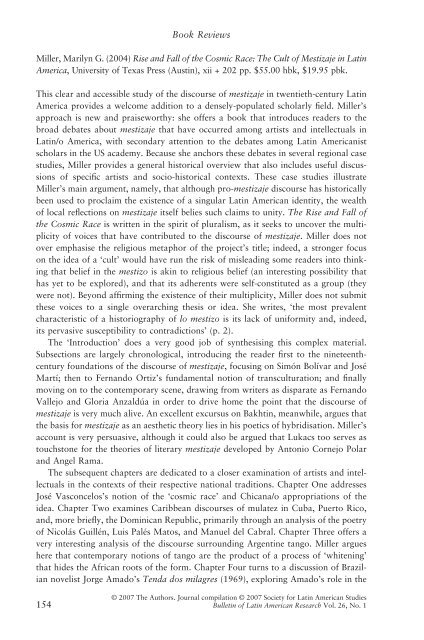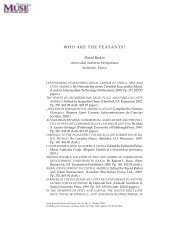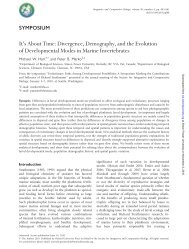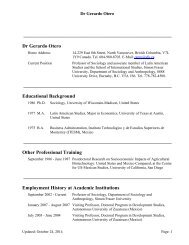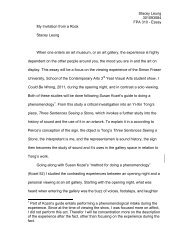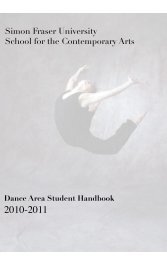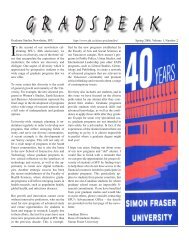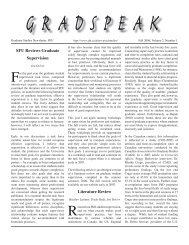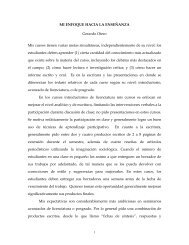Review of Mexico in Transition by Byron Crites
Review of Mexico in Transition by Byron Crites
Review of Mexico in Transition by Byron Crites
- TAGS
- transition
- byron
- crites
- cgi.sfu.ca
Create successful ePaper yourself
Turn your PDF publications into a flip-book with our unique Google optimized e-Paper software.
Book <strong>Review</strong>s<br />
Miller, Marilyn G. (2004) Rise and Fall <strong>of</strong> the Cosmic Race: The Cult <strong>of</strong> Mestizaje <strong>in</strong> Lat<strong>in</strong><br />
America , University <strong>of</strong> Texas Press (Aust<strong>in</strong>), xii + 202 pp. $55.00 hbk, $19.95 pbk.<br />
This clear and accessible study <strong>of</strong> the discourse <strong>of</strong> mestizaje <strong>in</strong> twentieth-century Lat<strong>in</strong><br />
America provides a welcome addition to a densely-populated scholarly fi eld. Miller ’ s<br />
approach is new and praiseworthy: she <strong>of</strong>fers a book that <strong>in</strong>troduces readers to the<br />
broad debates about mestizaje that have occurred among artists and <strong>in</strong>tellectuals <strong>in</strong><br />
Lat<strong>in</strong>/o America, with secondary attention to the debates among Lat<strong>in</strong> Americanist<br />
scholars <strong>in</strong> the US academy. Because she anchors these debates <strong>in</strong> several regional case<br />
studies, Miller provides a general historical overview that also <strong>in</strong>cludes useful discussions<br />
<strong>of</strong> specifi c artists and socio-historical contexts. These case studies illustrate<br />
Miller ’ s ma<strong>in</strong> argument, namely, that although pro- mestizaje discourse has historically<br />
been used to proclaim the existence <strong>of</strong> a s<strong>in</strong>gular Lat<strong>in</strong> American identity, the wealth<br />
<strong>of</strong> local refl ections on mestizaje itself belies such claims to unity. The Rise and Fall <strong>of</strong><br />
the Cosmic Race is written <strong>in</strong> the spirit <strong>of</strong> pluralism, as it seeks to uncover the multiplicity<br />
<strong>of</strong> voices that have contributed to the discourse <strong>of</strong> mestizaje . Miller does not<br />
over emphasise the religious metaphor <strong>of</strong> the project ’ s title; <strong>in</strong>deed, a stronger focus<br />
on the idea <strong>of</strong> a ‘ cult ’ would have run the risk <strong>of</strong> mislead<strong>in</strong>g some readers <strong>in</strong>to th<strong>in</strong>k<strong>in</strong>g<br />
that belief <strong>in</strong> the mestizo is ak<strong>in</strong> to religious belief (an <strong>in</strong>terest<strong>in</strong>g possibility that<br />
has yet to be explored), and that its adherents were self-constituted as a group (they<br />
were not). Beyond affi rm<strong>in</strong>g the existence <strong>of</strong> their multiplicity, Miller does not submit<br />
these voices to a s<strong>in</strong>gle overarch<strong>in</strong>g thesis or idea. She writes, ‘ the most prevalent<br />
characteristic <strong>of</strong> a historiography <strong>of</strong> lo mestizo is its lack <strong>of</strong> uniformity and, <strong>in</strong>deed,<br />
its pervasive susceptibility to contradictions ’ (p. 2).<br />
The ‘ Introduction ’ does a very good job <strong>of</strong> synthesis<strong>in</strong>g this complex material.<br />
Subsections are largely chronological, <strong>in</strong>troduc<strong>in</strong>g the reader fi rst to the n<strong>in</strong>eteenthcentury<br />
foundations <strong>of</strong> the discourse <strong>of</strong> mestizaje , focus<strong>in</strong>g on Simón Bolívar and José<br />
Martí; then to Fernando Ortiz ’ s fundamental notion <strong>of</strong> transculturation; and fi nally<br />
mov<strong>in</strong>g on to the contemporary scene, draw<strong>in</strong>g from writers as disparate as Fernando<br />
Vallejo and Gloria Anzaldúa <strong>in</strong> order to drive home the po<strong>in</strong>t that the discourse <strong>of</strong><br />
mestizaje is very much alive. An excellent excursus on Bakht<strong>in</strong>, meanwhile, argues that<br />
the basis for mestizaje as an aesthetic theory lies <strong>in</strong> his poetics <strong>of</strong> hybridisation. Miller ’ s<br />
account is very persuasive, although it could also be argued that Lukacs too serves as<br />
touchstone for the theories <strong>of</strong> literary mestizaje developed <strong>by</strong> Antonio Cornejo Polar<br />
and Angel Rama.<br />
The subsequent chapters are dedicated to a closer exam<strong>in</strong>ation <strong>of</strong> artists and <strong>in</strong>tellectuals<br />
<strong>in</strong> the contexts <strong>of</strong> their respective national traditions. Chapter One addresses<br />
José Vasconcelos ’ s notion <strong>of</strong> the ‘ cosmic race ’ and Chicana/o appropriations <strong>of</strong> the<br />
idea. Chapter Two exam<strong>in</strong>es Caribbean discourses <strong>of</strong> mulatez <strong>in</strong> Cuba, Puerto Rico,<br />
and, more briefl y, the Dom<strong>in</strong>ican Republic, primarily through an analysis <strong>of</strong> the poetry<br />
<strong>of</strong> Nicolás Guillén, Luis Palés Matos, and Manuel del Cabral. Chapter Three <strong>of</strong>fers a<br />
very <strong>in</strong>terest<strong>in</strong>g analysis <strong>of</strong> the discourse surround<strong>in</strong>g Argent<strong>in</strong>e tango. Miller argues<br />
here that contemporary notions <strong>of</strong> tango are the product <strong>of</strong> a process <strong>of</strong> ‘ whiten<strong>in</strong>g ’<br />
that hides the African roots <strong>of</strong> the form. Chapter Four turns to a discussion <strong>of</strong> Brazilian<br />
novelist Jorge Amado ’ s Tenda dos milagres (1969), explor<strong>in</strong>g Amado ’ s role <strong>in</strong> the<br />
© 2007 The Authors. Journal compilation © 2007 Society for Lat<strong>in</strong> American Studies<br />
154 Bullet<strong>in</strong> <strong>of</strong> Lat<strong>in</strong> American Research Vol. 26, No. 1


